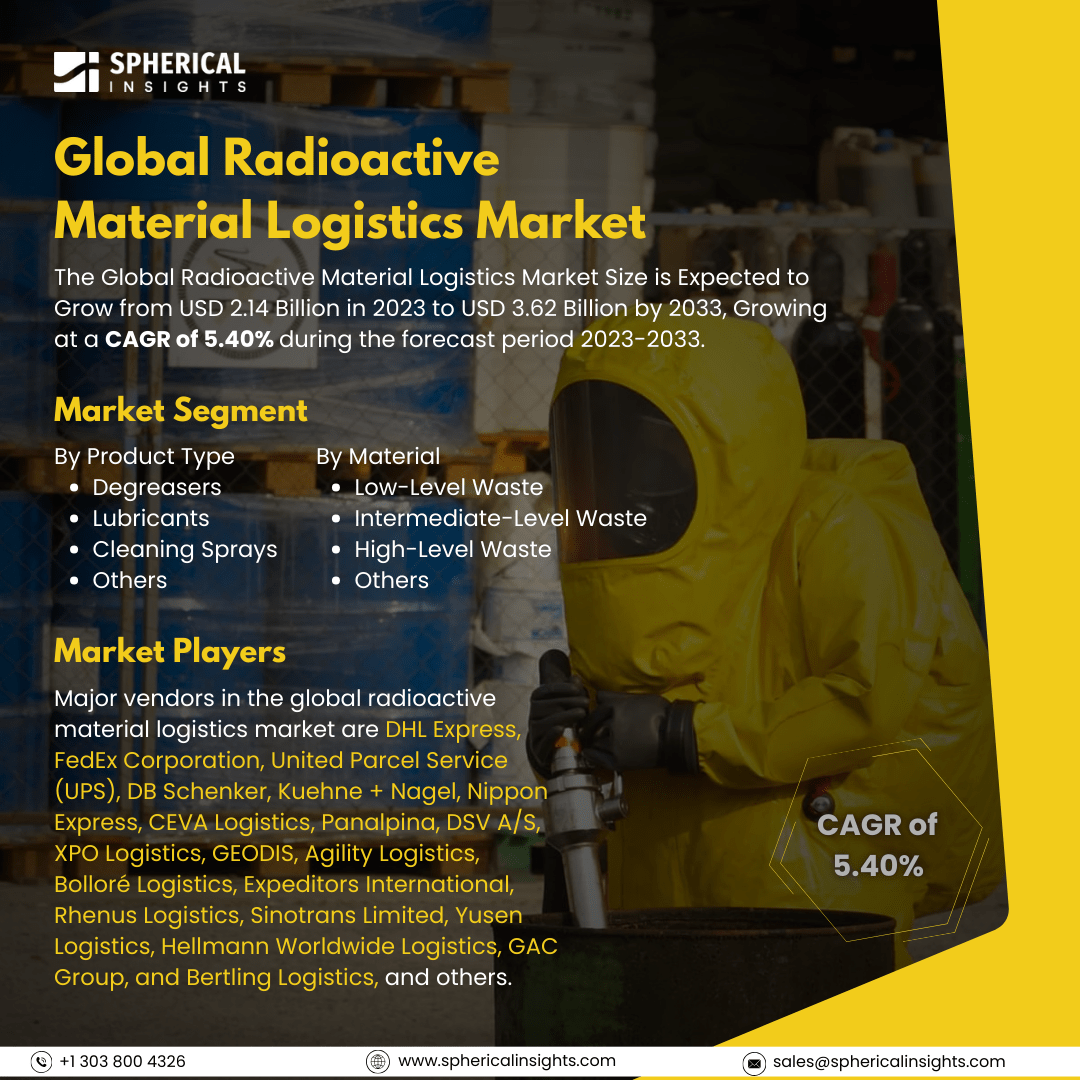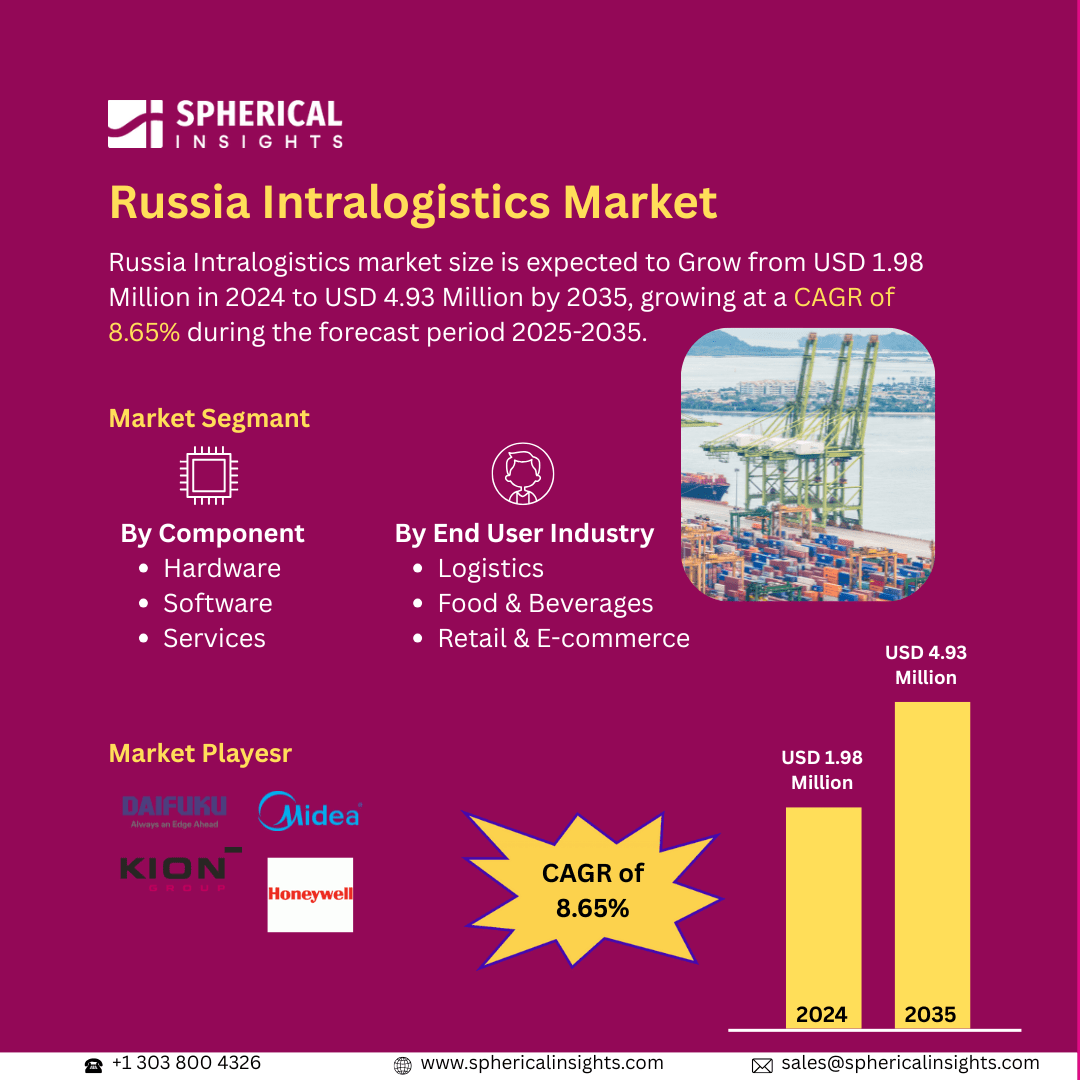Global Radioactive Material Logistics Market Size to Exceed USD 3.62 Billion By 2033
According to a research report published by Spherical Insights & Consulting, The Global Radioactive Material Logistics Market Size is Expected to Grow from USD 2.14 Billion in 2023 to USD 3.62 Billion by 2033, Growing at a CAGR of 5.40% during the forecast period 2023-2033.
Browse 210 market data Tables and 45 Figures spread through 190 Pages and in-depth TOC on the Global Radioactive Material Logistics Market Size, Share, and COVID-19 Impact Analysis, By Service Type (Transportation, Packaging, Storage, and Others), By Material Type (Low-Level Waste, Intermediate-Level Waste, High-Level Waste, and Others), By End-User (Nuclear Power Plants, Medical Institutions, Research Laboratories, Industrial Applications, and Others), and By Region (North America, Europe, Asia-Pacific, Latin America, Middle East, And Africa), Analysis And Forecast 2023 - 2033
The global radioactive material logistics market refers to the industry that focuses on the logistics and transportation sector dedicated to the safe and effective handling, packing, and shipping of radioactive materials. These materials are utilized in several industries, such as nuclear energy, industrial uses, and healthcare. The logistics process requires strict adherence to local, national, and international laws that safeguard the ecosystem, employees, and everyone else. The need for this market is driven by the growth of nuclear energy programs, the increasing use of radioactive materials in medicine, and the need for secure transportation of nuclear waste. The market is growing as a result of rigorous security standards and structures created by regulatory bodies. Additionally, advancements in technologies and the integration of telematics and IoT enhanced the efficiency and effectiveness of these services, which expanded this market revenue. However, market acquisition faces several obstacles, like high costs for infrastructure and lack of expert personnel for their upkeep.
The transportation segment held the greatest share of the global radioactive material logistics market in 2023 and is expected to grow at a significant CAGR over the forecast period.
On the basis of the service type, the global radioactive material logistics market is divided into transportation, packaging, storage, and others. Among these, the transportation segment held the greatest share of the global radioactive material logistics market in 2023 and is expected to grow at a significant CAGR over the forecast period. This is because to avoid contamination or leaks, this calls for specific vehicles and containers that adhere to strict safety regulations. Further, the need for dependable transportation services is being driven by the rise in nuclear power plants and medical facilities that use radioactive materials.
The high-level waste segment accounted for a significant share of the global radioactive material logistics market in 2023 and is projected to grow at a rapid pace during the forecast period.
On the basis of material type, the global radioactive material logistics market is categorized into low-level waste, intermediate-level waste, high-level waste, and others. Among these, the high-level waste segment accounted for a significant share of the global radioactive material logistics market in 2023 and is projected to grow at a rapid pace during the forecast period. This is due to this sector need for highly specialized transportation services that provide the greatest degree of safety and protection. Moreover, its extended half-lives and substantial radioactivity boost the segment expansion.
The nuclear power plants segment held the largest share of the global radioactive material logistics market in 2023 and is anticipated to grow at a notable CAGR over the forecast period.
On the basis of the end-user, the global radioactive material logistics market is segmented into nuclear power plants, medical institutions, research laboratories, industrial applications, and others. Among these, the nuclear power plants segment held the largest share of the global radioactive material logistics market in 2023 and is anticipated to grow at a notable CAGR over the forecast period. This segment growth contributed to the market expansion because of ensures the safe and efficient operation of such as radioactive fuel or garbage must be carried, packaged, and stored. Moreover, the segment expansion is boosted due to the necessity of an increasing number of nuclear-powered initiatives worldwide.
North America is anticipated to hold the largest share of the global radioactive material logistics market over the forecast period.
North America is expected to hold the greatest share of the global radioactive material logistics market over the forecast period. The regional market growth is increasing due to strong legislation and established nuclear facilities. Further, the need for specialist logistical services in this region is fueled by the substantial number of nuclear power plants and modern healthcare facilities that utilize radioactive materials.
Europe is projected to grow at the fastest CAGR growth of the global radioactive material logistics market over the forecast period. The market expansion across the region is further accelerated because of its several nuclear energy plants and ongoing studies on radioactive materials. Further, countries possessing advanced regulations that ensure the safe handling and transit of radioactive materials notably the UK, France, and Germany boost the market expansion.
Company Profiling
Major vendors in the global radioactive material logistics market are DHL Express, FedEx Corporation, United Parcel Service (UPS), DB Schenker, Kuehne + Nagel, Nippon Express, CEVA Logistics, Panalpina, DSV A/S, XPO Logistics, GEODIS, Agility Logistics, Bolloré Logistics, Expeditors International, Rhenus Logistics, Sinotrans Limited, Yusen Logistics, Hellmann Worldwide Logistics, GAC Group, and Bertling Logistics, and others.
Key Target Audience
- Market Players
- Investors
- End-users
- Government Authorities
- Consulting And Research Firm
- Venture capitalists
- Value-Added Resellers (VARs)
Recent Development
- In February 2025, Rail transport played a significant role in improving nuclear waste management in Cumbria. The Low-Level Waste Repository (LLWR) in West Cumbria initiated a project to enhance the long-term safety of radioactive waste storage. This involved using rail to deliver 280,000 tons of aggregate for capping operations, which created a protective barrier.
Market Segment
This study forecasts revenue at global, regional, and country levels from 2023 to 2033. Spherical Insights has segmented the global radioactive material logistics market based on the below-mentioned segments:
Global Radioactive Material Logistics Market, By Service Type
- Transportation
- Packaging
- Storage
- Others
Global Radioactive Material Logistics Market, By Material
- Low-Level Waste
- Intermediate-Level Waste
- High-Level Waste
- Others
Global Radioactive Material Logistics Market, By End User
- Nuclear Power Plants
- Medical Institutions
- Research Laboratories
- Industrial Applications
- Others
Global Radioactive Material Logistics Market, By Regional
- North America
- Europe
- Germany
- UK
- France
- Italy
- Spain
- Russia
- Rest of Europe
- Asia Pacific
- China
- Japan
- India
- South Korea
- Australia
- Rest of Asia Pacific
- South America
- Brazil
- Argentina
- Rest of South America
- Middle East & Africa
- UAE
- Saudi Arabia
- Qatar
- South Africa
- Rest of the Middle East & Africa



